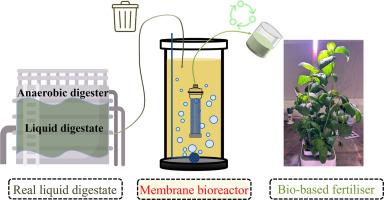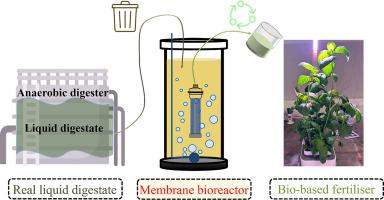通过膜生物反应器将液体厌氧消化物转化为液体肥料:一项概念验证研究
IF 12.4
1区 环境科学与生态学
Q1 ENGINEERING, ENVIRONMENTAL
引用次数: 0
摘要
在循环生物经济中,富含营养的液体厌氧消化液作为微量和大量营养物质和增值有机化合物的可再生原料具有巨大的潜力。膜生物反应器提供了一种紧凑而有效的从废水中回收营养物质的策略,然而迄今为止尚未探索在液体厌氧消化中的应用。在这项概念验证研究中,使用配备浸没超滤膜的实验室规模膜生物反应器,通过生物硝化将真正的液体厌氧消化物转化为液体N-P-K肥料。膜生物反应器运行7个月,达到446±48 mgN∙L-1∙d-1的高硝化率,去除总有机碳约80%。亚硝基球菌和硝化螺旋菌属负责将氨转化为硝酸盐。亚硝酸盐氧化菌(NOB)与氨氧化菌(AOB)之比与水力停留时间有关,NOB:AOB之比大于5与硝化过程加速相关,水力停留时间减少58%,NH4 +转化率稳定在54%。所获得的液体肥料富含微量和大量营养素以及腐殖质化合物,在罗勒(Ocimum Basilicum)的水培生长中优于商业肥料,与具有类似营养配方的商业肥料相比,可提供100%的新鲜生物量增加。这项研究将为营养物质的循环生物经济奠定基础,在这种经济中,廉价而丰富的废物,如液体厌氧消化物,被转化为增值的可再生肥料。本文章由计算机程序翻译,如有差异,请以英文原文为准。


Valorisation of liquid anaerobic digestate into liquid fertilisers via membrane bioreactors: a proof-of-concept study
Nutrient-rich liquid anaerobic digestate holds great potential as renewable feedstock of micro- and macro-nutrients and value-added organic compounds in a circular bioeconomy. Membrane bioreactors offer a compact and efficient strategy to recover nutrients from wastewater, nonetheless no applications on liquid anaerobic digestate have been explored to date. In this proof-of-concept study, real liquid anaerobic digestate was valorised into liquid N–P–K fertilisers by biological nitrification, using a laboratory-scale membrane bioreactor fitted with submerged ultrafiltration membranes. The membrane bioreactor was operated for seven months, achieving a high nitrification rate of 446 ± 48 mgN∙L-1∙d-1 while removing ∼80 % of total organic carbon. Nitrosococcus and Nitrospira genera were responsible for the conversion of ammonia into nitrate. The nitrite oxidising bacteria (NOB) to ammonia oxidising bacteria (AOB) ratio was linked to the hydraulic retention time, revealing that NOB:AOB ratio greater than 5 was correlated with an accelerated nitrification process, achieving a 58 % reduction in hydraulic retention time while maintaining a stable NH4+ conversion rate of 54 %. The obtained liquid fertiliser, rich in micro- and macro-nutrients and humic compounds, outperformed a commercial fertiliser in the hydroponic growth of basil (Ocimum Basilicum), affording a 100 % increase in fresh biomass compared to the commercial fertiliser presenting a similar nutrient formulation. This study will lay the foundation of a circular bioeconomy of nutrients whereby inexpensive and abundant waste, such as liquid anaerobic digestate, is valorised into value-added renewable fertilisers.
求助全文
通过发布文献求助,成功后即可免费获取论文全文。
去求助
来源期刊

Water Research
环境科学-工程:环境
CiteScore
20.80
自引率
9.40%
发文量
1307
审稿时长
38 days
期刊介绍:
Water Research, along with its open access companion journal Water Research X, serves as a platform for publishing original research papers covering various aspects of the science and technology related to the anthropogenic water cycle, water quality, and its management worldwide. The audience targeted by the journal comprises biologists, chemical engineers, chemists, civil engineers, environmental engineers, limnologists, and microbiologists. The scope of the journal include:
•Treatment processes for water and wastewaters (municipal, agricultural, industrial, and on-site treatment), including resource recovery and residuals management;
•Urban hydrology including sewer systems, stormwater management, and green infrastructure;
•Drinking water treatment and distribution;
•Potable and non-potable water reuse;
•Sanitation, public health, and risk assessment;
•Anaerobic digestion, solid and hazardous waste management, including source characterization and the effects and control of leachates and gaseous emissions;
•Contaminants (chemical, microbial, anthropogenic particles such as nanoparticles or microplastics) and related water quality sensing, monitoring, fate, and assessment;
•Anthropogenic impacts on inland, tidal, coastal and urban waters, focusing on surface and ground waters, and point and non-point sources of pollution;
•Environmental restoration, linked to surface water, groundwater and groundwater remediation;
•Analysis of the interfaces between sediments and water, and between water and atmosphere, focusing specifically on anthropogenic impacts;
•Mathematical modelling, systems analysis, machine learning, and beneficial use of big data related to the anthropogenic water cycle;
•Socio-economic, policy, and regulations studies.
 求助内容:
求助内容: 应助结果提醒方式:
应助结果提醒方式:


